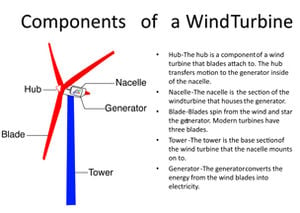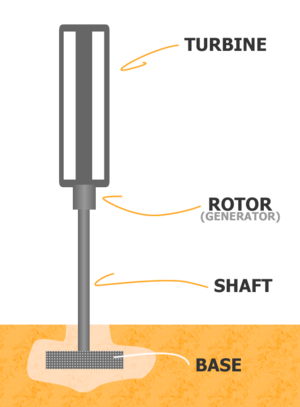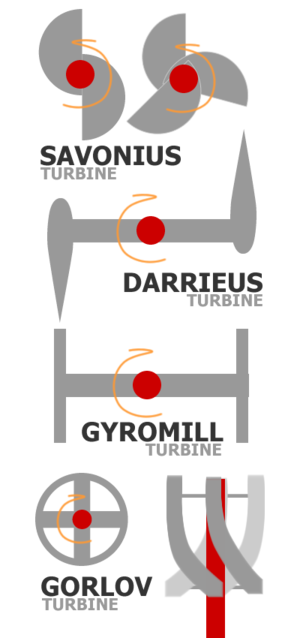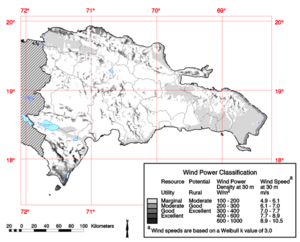
Wind is a renewable resource that can be utilized by converting the kinetic power of wind into mechanical power. The mechanical power is then used to run a generator, transferring the mechanical power into electricity.
Small scale wind energy systems include:
- Wind turbine systems with turbines that have a rotor area of less that 200 sq. meters[1]
- Systems that produce less that 100 kilowatts (ex. wind belts, wind turbines)
- Off-grid systems, meaning that the systems are not connected to the electrical grid
Selecting a Site[edit | edit source]
Many variables factor into selecting a site for installing a small scale wind system. In order to calculate the feasibility of installing a small scale wind system one must:
- Determine your electricity usage cost in kWh
- Determine site suitability
For a wind turbine, it is recommended to have a free acre of land to install the system on. This reduces wind turbulence, which is the result of wind passing over and around objects such as buildings.
- Analyze your wind resource
An annual average wind speed of 10 miles per hour is recommended for systems that are connected to the grid. Small increases in average wind speeds result in large increases in power produced.
- Determine your demand
Determine the amount of electricity that the system is required to produce. This calculation will aid in the decision making process of selecting the right wind energy system.
- Research government policies & incentives
Government policies and incentives may reduce or increase the feasibility of installing a wind energy system.
- Calculate the estimated cost and buy-back time of the system
Calculating the Estimated Buy-Back Time of a System[edit | edit source]
First, estimate the total initial cost and maintenance costs of the system.
Second, use the following equation:
where:
Third, compare the results in order to determine the feasibility of installing the system.
VAWT's[edit | edit source]

Vertical Axis Wind Turbines are a type of wind actioned turbines, which by force of wind applied to its blades, get to spin a rotor perpendicularly located against soil. Different designs are used for these systems.
Designs such as the Darrieus, Savonius and Gyromill Turbine are the most common and studied. Newer turbines, such as the Gorlov or helicoidal turbines are just being developed with promising results. Being far more eficcient, cheaper and even structurally stronger than older designs. The helicoidal turbine, mentioned is derived from the Savonius turbine principle, hybridized with the concept of a helicoidal shape.
Advantages of Vertical Axis Wind Turbines[edit | edit source]

- Can be avoided by birds easily.
- They don't need to be as high as HAWTs, making mantainance easier.
- No need to rotate blades as wind shifts direction.
- Lower inertia.
- As mass of the 'helix' or 'turbine' is concentrated, it's less prone to structural failure by high winds.
- Adaptability to wind speeds.
- Can be as efficient, or even more so than HAWTs.
Disdvantages of Vertical Axis Wind Turbines[edit | edit source]
- As these systems are usually built in low scale, they don't take advantage of high height winds.
- Still young on development.
- Different costs depending on design.
Controversies[edit | edit source]
It seems as there is a whole fight on what are the advantages of VAWT's against HAWT's. This is due to diversified thoughts on how durable, efficient and costly a VAWT system might be compared to the known and all proven up HAWT systems. In some sources you might find that these systems are prone to failing[3]even though in others you will find that the system is praised because of its simple mantainance needs[4][5]
Wind Energy in the Dominican Republic[edit | edit source]
Small Scale Wind[edit | edit source]
The Dominican Republic has the resources for small scale wind systems. It is estimated that 6% of Dominican land is rated good for small scale wind power systems. This land has the potential to support 30,000 MW, and could supply 60 billion kWh/yr.[6]

Large Scale Wind[edit | edit source]
The Dominican Republic possesses windy land areas that range from good to excellent resource potential for large scale systems. This land covers 3% of the Dominican Republic. Using 7MW per sq. kilometer, it has been estimated that this land can be used to supply 10,000 MW. Twenty provinces possess greater than 100 MW capability while three more provinces possess 1000 MW capability.
As of now, there isn't any large scale projects operating in the Dominican Republic, aside from private households or companies that are using wind power individually.The most recent attempt at installing and operating a large scale system failed as investors decided not to continue to support the project.
For information on Dominican Republic's Wind Energy possibilities: Dominican Republic Wind Energy Resource Atlas Development
References[edit | edit source]
- ↑ W. Hulshorst <http://www.slideshare.net/sustenergy/small-scale-wind-energy>
- ↑ Cathy Svejkovsky <http://web.archive.org/web/20090305060859/http://attra.ncat.org/attra-pub/PDF/smallscalewindenergy.pdf>
- ↑ Vertical Axis Wind Turbines. <http://peswiki.com/index.php/Directory:Vertical_Axis_Wind_Turbines/>
- ↑ Turbina eólica. <http://es.wikipedia.org/wiki/Turbina_e%C3%B3lica#Ventajas_de_las_turbinas_verticales/>
- ↑ Aerogeneradores de eje vertical. <http://web.archive.org/web/20140529205134/http://panemona.com.ar/aerogeneradores-de-eje-vertical-aero-generadores-p_122.htm>
- ↑ D. Elliot <http://www.nrel.gov/docs/fy99osti/27032.pdf>
- ↑ Elliot, Dennis L. "Dominican Republic: Most Favorable Wind Resource Areas." Map. Dominican Republic Wind Energy Resource Atlas Development. National Renewable Energy Laboratory. Print.




